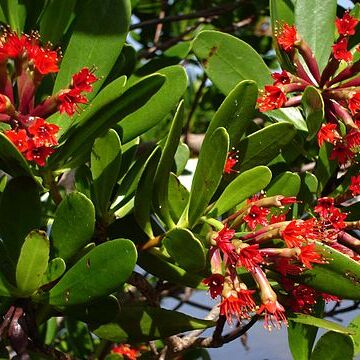Trees to 7(-25) m tall; trunk to 0.5 m d.b.h. Bark dark blackish brown, deeply longitudinally fissured. Branchlets reddish or green when young, glabrous. Leaf blade dark green adaxially, oblanceolate or narrowly oblong-oblanceolate, (2-)4-8 × 1-3 cm, apex retuse or rounded; lateral veins in 4 or 5 pairs. Inflorescences terminal, 3-4.5 cm. Calyx tube 12-18 mm; bracteoles 1.5-2 mm; lobes broadly triangular, 1-1.5 mm, apex obtuse. Petals bright red, oblong-elliptic, 5-6 mm, apex obtuse or acuminate. Stamens 5-10 (usually 7), ca. 10 mm, ca. 2 × as long as petals. Style ca. 10 mm. Fruit blackish brown when ripe, fusiform, 1.6-2 cm × 4-5 mm excluding stipe, longitudinally striate; stipe ca. 5 mm. Fl. Nov-Dec, May, fr. Jun-Aug.
A small tree 3-5 m high. It spreads to 9 m wide. It can be larger. It has slender knee shaped roots allowing air. The bark is rough and dark grey. It has cracks along its length. The leaves are arranged in spirals. They are crowded towards the ends of branches. The leaves are smooth, slightly fleshy and leathery. They are spoon shaped and taper towards the base. The leaves are 2-8 cm long by 1.2-2.5 cm wide. The flowers are red tubes with a strong scent. They are 1.5-2 cm long. Many flowers occur together in flower clusters near the ends of branches. These flower clusters are 2-5 cm long. The fruit are hard and smooth. They are 1 cm long by 0.5 cm wide. They are corky and have a single seed.
Shrub or tree to 10 m high, with knee-shaped pneumatophores on roots. Branchlets glabrous. Leaves: lamina obovate, 2–8 cm long, 1–2.5 cm wide, cuneate at base, entire, occasionally appearing crenate due to presence of glands, retuse at apex, glabrous; petiole absent or to 5 mm long. Inflorescence a terminal raceme. Flowers red; pedicel to 3 mm long. Ovary narrowly conical below for 8–15 mm, expanded above into a calyx tube with wide calyx lobes c. 1 mm long. Petals 4–5 mm long, 1.5–2 mm wide. Stamens 5–10; filaments to 1 cm long. Style to 1 cm long. Fruit narrowly ellipsoidal, 1–1.5 cm long including persistent calyx lobes.


